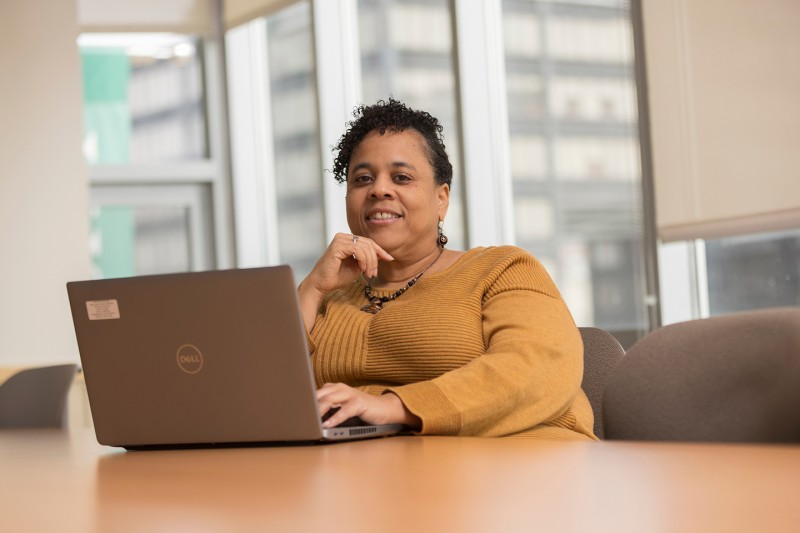Climbing the waterfall
Assistant Professor of Social Work Monica Adams intertwines nutrition, health and social equity.

While pursuing her Master of Social Work degree, Monica Adams was strongly influenced by an analogy shared by a professor, one that helped change the trajectory of her career.
“The professor compared social work to a waterfall,” she recalls. “He asked us to imagine people falling over the edge: at the bottom, individuals are pulling people out; these are the clinical social workers who handle day-to-day cases. However, at some point, someone needs to go to the top of the waterfall to understand why people are falling over it and to see what can be done to either stop or slow down that flow.”
After 20 years as a clinician, Adams realized: “I had to go up top to help a larger number of people.”
Today, she is an assistant professor in CCPA’s Department of Social Work, sharing her expertise with a new generation. She researches food insecurity as a social determinant of health, examining its impact on individuals and developing strategies to reduce health disparities.
Adams completed a qualitative study examining the eating and physical activity behaviors of low-income women from a strength perspective. She investigated how most of these women, despite living in an environment that encourages unhealthy eating and minimal physical activity, are not obese (as measured by BMI). Her work explored protective factors against obesity that supported these women’s efforts to manage their weight, with the ultimate goal of using that knowledge to develop interventions to support them.
Through her interviews, Adams found that most women, particularly those with children, were motivated to be healthy not by concerns about their appearance but by a desire to serve as positive role models for their kids. Those with children also described applying information from their child’s pediatrician to their own eating and physical activity behaviors. Adams also discovered that many of these women measured their desire to lose weight in ways that went beyond the scale.
“They recognized changes in their bodies, such as becoming breathless when climbing stairs or noticing that their clothes no longer fit properly,” she says.
Many of the women with children also discussed engaging in physical activity related to their children, such as taking them to the park and walking them to and from school.
While all the women expressed concerns about safety when walking in their neighborhoods, Adams notes that women without children were more willing to make accommodations to walk in their neighborhoods than those with children.
“The non-mothers avoided walking at night or always walked with a friend; one even said she carried a weapon, while the mothers chose instead to walk in either a nearby, safer neighborhood or a relative’s neighborhood,” she says.
These insights have opened new avenues for Adams to explore:
● How can healthcare professionals use mothers’ motivation to be positive role models to approach the topic of weight differently and support women in making healthy eating choices?
● How can healthcare professionals help women integrate weight management into their daily activities and experiences so it becomes more tangible and relatable?
● What if baby wellness visits were used as an opportunity to discuss the entire family’s nutrition needs, taking into account the family’s budget?
Community-engaged studies
To gain deeper perspectives, Adams and MSW students Makayla Fargnoli and Eden Lowinger spent last summer riding with the Greater Good Grocery Store’s mobile market, a school bus transformed into a miniature grocery store that travels to Broome County neighborhoods without full-service grocery stores, known as “food deserts.” The GGG’s brick-and-mortar store provides access to fresh and healthy food on the north side of Binghamton (also a food desert) and is open to people regardless of income.
“We watched, learned and paid attention,” Adams recalls. “Then we talked about what we had seen and decided to focus on examining how this mobile market is making a difference in the community, with the hope that once the study is published, the data can be shared and more mobile markets can be created because there’s a lot of food insecurity in this area and the U.S. in general.”
Adams has three additional projects that investigate food insecurity, one focusing on individuals with intellectual and developmental disabilities and another examining food insecurity within the LGBTQ+ community. She notes there is a lack of information about how food insecurity impacts these populations.
“We’re reviewing the literature to explore the prevalence of food insecurity in these groups, the unique consequences they face, and the specific risk and protective factors that are relevant to them,” Adams says.
She strongly opposes a one-size-fits-all method for addressing food insecurity, noting that in the Black community, which disproportionately experiences food insecurity, the church plays a major role. But the same approach might not be so easily accomplished for someone who is Black, food insecure and LGBTQ.
Adams’ third study examines how neighborhood characteristics beyond racial composition contribute to race-based health disparities.
By expanding her research to understand what’s needed to eliminate or reduce the negative impacts of food insecurity on health outcomes, she’s keeping herself at the top of that proverbial waterfall.
“There isn’t a lack of food in our country. That’s not the problem, so what is the problem?” Adams says. “I think we can better understand food insecurity if we see how people interact with and live with it daily.”
